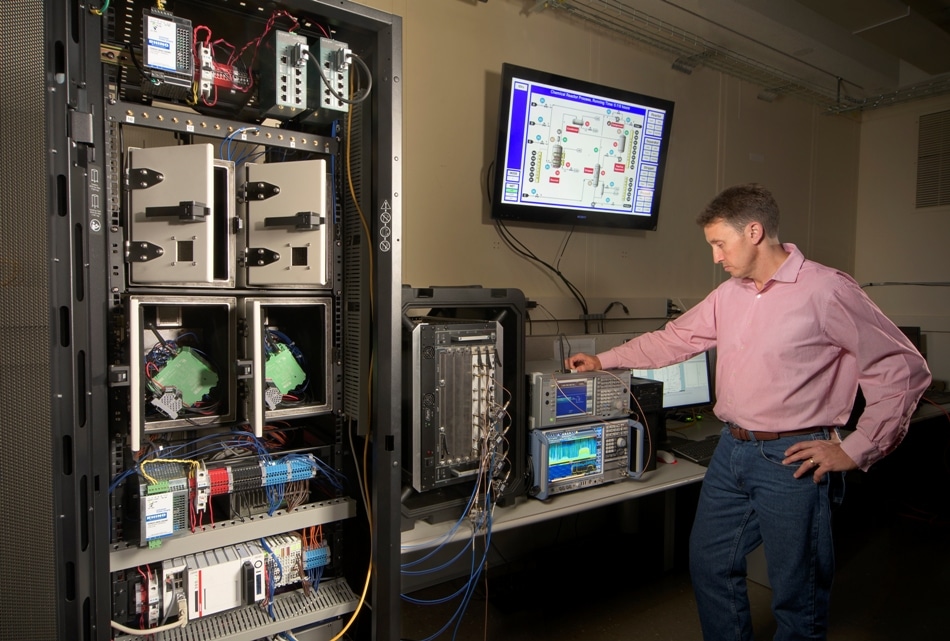May 30 2018
Termed the “smart factory,” it has even been given the exalted label of “the fourth industrial revolution.”
 Using a novel testbed that recreates factory environments in the lab, NIST engineer Rick Candell helps “cut the cords” (and wires) from industrial communications networks by studying how different factory layouts affect wireless radio frequencies, and in turn, how this impacts factory performance. (Credit: Earl Zubkoff)
Using a novel testbed that recreates factory environments in the lab, NIST engineer Rick Candell helps “cut the cords” (and wires) from industrial communications networks by studying how different factory layouts affect wireless radio frequencies, and in turn, how this impacts factory performance. (Credit: Earl Zubkoff)
In the not-far-away future, the manufacturing operation will involve networked systems monitoring and directing processes, machines communicating with humans and with one another at higher speeds, and the factory itself making decisions in relation to optimizing and facilitating production.
Perceiving that reliable wireless communications will be required to make it possible, the National Institute of Standards and Technology (NIST) has launched the first-ever set of science-based guidelines to assist users in selecting the ideal wireless system for any particular industrial environment, designing tailor-made setup to enable it, successfully deploying it, and then ensuring that the network works as expected.
The elimination of physical connections such as cables and wires from the communication network of a facility, wireless technology enables various utility, chemical processing, and manufacturing organizations to run their whole operation in a highly productive and highly efficient manner, at a lesser cost. Yet, considerations related to security, integrity, and reliability have hindered the adoption and application of industrial wireless, specifically because wireless communication can often be disrupted by interference and obstructions in drastic industrial settings.
As part of its Wireless Systems for Industrial Environments project, NIST has collaborated with standards organizations and private-sector collaborators to overcome these obstacles and make industrial wireless communication the first choice for companies. As part of this attempt, in March 2017, NIST and the Institute of Electrical and Electronics Engineers (link is external) (IEEE) organized a technical working group of experts on wireless communications from academia, industry, and government to develop “a succinct yet comprehensive, easy-to-use reference guide and best practices manual for anyone, from control engineers to factory managers, to integrate a robust, safe, reliable and secure wireless system into their unique industrial landscape,” stated Rick Candell, an electronics engineer in NIST’s Engineering Laboratory.
Candell stated that the new how-to guide thoroughly and clearly explains to a user how to achieve the ideal wireless fit for their particular operation. The document offers valuable tools, strategies, and background that help users
- Gain knowledge of wireless technologies and networking basics, such as a glossary of terms, a list of technical challenges (such as latency, the time it takes for data to go from source to target), and a review of radio frequency (RF) considerations
- Make a business case for wireless
- Break down the components of a complete wireless lifecycle, from defining objectives to deploying and monitoring the final system
- Employ wireless to improve factory safety
- Protect and secure a wireless network
- Gain knowledge of ideal wireless practices, such as optimal antenna placement, getting around obstructions and interference problems, and preventing redundant signal paths
- Following a set of easy-to-use checklists for each element of the wireless deployment lifecycle, such as evaluation of the factory and its operations for communications requirements, comparison of available technologies, and methodical designing and deployment of a working wireless system
The guide is completed by a series of best-practice case studies, indicating the strategies to be used to enhance and optimize wireless in various factory situations.
For example, one scenario looks at a common but often overlooked problem when using wireless communications: dealing with the RF interference that may arise from microwave ovens, Bluetooth devices and other nonoperational items that personnel are using. The guide tells how to identify the sources of such interference, measure how they impact factory operations, and then use the data to choose the most appropriate solution from those described in the text.
Rick Candell, Electronics Engineer, NIST’s Engineering Laboratory
The guide describes another case study, which demonstrates the ability of properly deployed wireless to prevent a hazardous work environment.
“Wireless gas sensors can monitor the accumulation of poisonous or combustible gases in a work setting but only if all of the signal transmission and propagation challenges in that area are considered,” explained Candell. “We use the example of a welder in a confined space whose torch is producing carbon monoxide gas, and show how successful, continuous monitoring depends on critical factors such as antenna placement and the use of multiple sensors in case one fails.”
Candell stated that future guides from NIST will deal with more advanced communications scenarios such as wireless technologies for control of mobile and collaborative robotics in the factory setting.